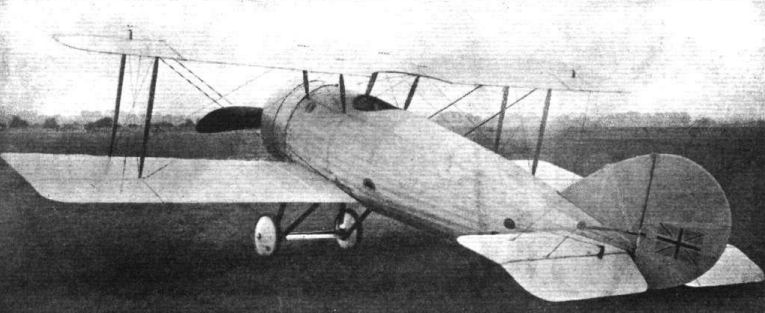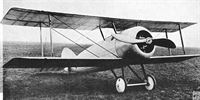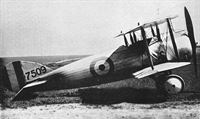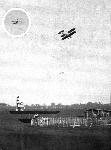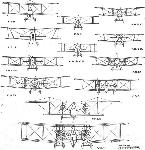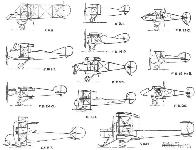C.Andrews Vickers Aircraft since 1908 (Putnam)
Vickers Designs 1914-18
When war broke out in 1914 there was a serious shortage of British military aircraft compared with those possessed by France and Germany, and various aeronautical experimenters made efforts to remedy this deficiency. Among these private-venture attempts was one by Harold Barnwell, who had been appointed chief test pilot by Vickers after the closing of their flying school at Brooklands. In spare moments from testing production Gunbuses he took upon himself the task of designing and constructing under cover a small high-speed scout, fitted with a Gnome engine spirited out of Vickers' Erith stores.
Barnwell's creation was a tubby little machine with a circular-section streamlined fuselage and stubby unstaggered wings of small span. It soon acquired the name of the Barnwell Bullet. On its first flight early in 1915, in the hands of its designer, it was found to have insufficient control, particularly on the elevators. On landing, its undercarriage collapsed, and the Bullet stood on its nose. This mishap must have revealed its existence to Vickers' management, for R. K. Pierson, a young graduate apprentice then in the drawing office who had also learned to fly at Vickers' Flying School, was given the task of redesigning the Bullet into an experimental scout with the designation of E.S.1, powered with a Gnome monosoupape engine.
E.S.1 had larger tail surfaces than those of the original Barnwell Bullet and a stronger undercarriage. No armament was carried. After a period of flight testing it was sent to the Central Flying School at Upavon for official trials. Certain disadvantages were disclosed, particularly in the pilot's view upwards as well as downwards over the side of the fat body. There was no drain hole in the engine cowling to jettison surplus oil and petrol vapour centrifuged by the rotary engine.
An improved version was then developed with the 110 hp Clerget rotary engine. A small window of celluloid was inserted in the top centre section to improve the pilot's view upwards, and the fairing was removed from the underside of the fuselage. In this form the type was known to Vickers as the E.S.2. (In official documents it appears as E.S.I Mk. II) Two were made, and one was used for trials of the Vickers-Challenger gun synchronising gear which enabled a fixed machine-gun to be fired through a tractor propeller. This gear was used operationally on the Sopwith One-and-a-half Strutter two-seat fighter. In the summer of 1916 one E.S.2, equipped with a forward-firing fixed Vickers gun and the synchronising gear, was sent to France for operational trials by No. 11 Squadron, RFC, then operating Vickers Gunbuses. There it kept company with a small number of Bristol Scouts, but reports on the Vickers Bullet, as the E.S.2 was known, confirmed the CFS opinion of the E.S.1 that it was too blind from the pilot's point of view. The E.S.2 was also flown before H.M. King George V during a visit to Vickers' Crayford works in September 1915 and demonstrated to a visiting Russian Imperial aviation mission.
E.S.1 - Barnwell Bullet rebuilt - One 100 hp Gnome monosoupape. Span 24 ft 4 1/2 in; length 20 ft 3 in; height 8 ft; wing area 215 sq ft. Empty weight 843 lb; gross weight 1,295 lb. Max speed 114 mph at 5,000 ft; climb to 10,000 ft - 18 min; endurance 3 hr. No armament.
E.S.2 - Bullet - One 110 hp Clerget. Span 24 ft 5 1/2 in; length 20 ft 3 in; height 8 ft; wing area 215 sq ft. Empty weight 981 lb; gross weight 1,502 lb. Max speed 112.2 mph at ground level; climb to 10,000 ft - 18 min; service ceiling 15,500 ft; initial climb 1,000 ft/min; endurance - 2 hr at 8,000 ft. Armament one Vickers gun (synchronised by Vickers Challenger interrupter gear).
Показать полностью
P.Lewis The British Fighter since 1912 (Putnam)
Under Harold Barnwell’s direction a new tractor scout, the E.S.1, was designed and built. Powered by the 100 h.p. Monosoupape Gnome rotary, the machine was completed in August, 1915, and was a single-bay, equal-span, non-staggered biplane of very neat and refined aspect. The lines of the broad-chord cowling flowed back into the fuselage along formers and stringers applied over the main wooden fuselage rectangular structure. Taper was introduced aft of the cockpit but the practice of carrying to some distance to the rear of the engine the full circular section of the engine cowling resulted in a comparatively inferior view from the cockpit along the bulky nose portion. Nevertheless, the E.S.1’s streamlining endowed it with a creditable top speed of 114 m.p.h. at 5,000 ft., and earned it the soubriquet of the Barnwell Bullet. As No. 7509, the E.S.1 went to France for Service Trials with the R.F.C. but was ultimately written off in a crash.
The machine’s excellent performance was obviously worth exploiting and a modified version, the E.S.2, was ready in September, 1915. In this, the squared-off wingtips of the E.S.l had been replaced with those of rounded outline and the pilot’s view which, in the earlier machine had been commented on adversely, was improved in an upward direction by the provision of a generous opening in the upper centre-section. Altered also were the lower portion of the fuselage which, in the E.S.2, was flat instead of rounded and resulted in decreased depth, and the 110 h.p. Clerget’s cowling which was of reduced chord.
A positive attempt was made in the E.S.2 to produce a tractor scout equipped with a fixed forwards-firing gun. This was accomplished by mounting a Vickers gun in a trough to port in the upper decking and synchronizing it to fire between the propeller blades by incorporating the interrupter gear which had been produced by Vickers in collaboration with G. H. Challenger.
Even though the E.S.2 possessed a good performance and a long-awaited answer to the old gun-aiming problem, the two built - 7759 and 7760 - remained as prototypes only. Despite its several attributes, the type was dogged by the relatively poor view from the cockpit, owing to the plumpness of the generous cross-section of the fuselage. Nevertheless, the E.S.2 was a commendable step in the right direction and provided Vickers with valuable experience which was put to good use later. As an alternative to the 110 h.p. Clerget, the le Rhone of the same power was tested also in the airframe.
Показать полностью
F.Mason The British Fighter since 1912 (Putnam)
Vickers E.S.1 and E.S.2
Harold Barnwell’s E.S.1 was, like the F.B.7, first flown in August 1915 and, on account of its remarkable performance, became popularly known as the Barnwell Bullet. In appearance it was very advanced for its day, being a single-bay, unstaggered biplane with fully-cowled 100hp Gnome monosoupape engine. The wooden fuselage was of circular section almost as far aft as the tailplane, and its speed performance (117 mph at sea level) was largely attributable to careful attention to detail design. Wings and tailplane were of rectangular planform, and the fin was gracefully curved to blend with a rounded rudder.
Such was the extraordinary performance demonstrated by the E.S.1 that the War Office sent the only example, No 7509, to France for operational trials with line pilots, although it was in fact unarmed. Unfortunately the E.S.1 met with outspoken criticism from Service pilots who complained that the bulky fuselage and upper wing severely restricted the view from the cockpit. Moreover, being fully cowled, the engine frequently overheated and the aircraft narrowly escaped being consumed by fire. It was eventually written off by Capt P H L Playfair (later Air Marshal Sir Patrick, kbe, cb, cvo, mc).
Encouraged to pursue the design, Vickers had already produced the E.S.2 (sometimes referred to as the E.S.1 Mark II), and this flew in September 1915 with a 110hp Clerget in a shorter chord cowling. Most obvious changes, however, were embodied in the wings which now featured rounded tips of slightly greater span, and an enlarged trailing edge cut-out as well as an aperture in the centre section between the spars to improve the pilot’s field of vision.
Later the Clerget was replaced by a Le Rhone of similar power, and this returned a speed similar to that of the E.S.1 - despite the inclusion of armament in the later aircraft. This comprised a fixed Vickers machine gun mounted on the port upper longeron forward of the cockpit and recessed into the nose decking to fire forward through the propeller by means of the new Vickers-Challenger interrupter gear.
Although the fuselage section was of marginally smaller diameter, the E.S.2 still met with opposition from pilots for its lack of downward visibility, and the E.S.2 (of which two examples were produced) was abandoned. Their value nevertheless lay in the experience they afforded Vickers in the development of later tractor scouts which, from early 1916, began to replace the old pusher Gunbus formula in service.
Type: Single-engine, single-seat, single-bay biplane scout.
Manufacturer: Vickers Ltd (Aviation Department), Knightsbridge, London.
Powerplant: E.S.1. 100hp Gnome monosoupape engine. E.S.2. 110hp Clerget; 110hp Le Rhone.
Structure: Predominantly wooden construction with fabric covering. Ailerons on upper and lower wings; twin-wheel undercarriage without skid.
Dimensions: E.S.1. Span, 24ft 4 1/2 in; length, 20ft 3in; height, 8ft 0in; wing area, 215 sq ft. E.S.2 (Clerget). Span, 24ft 5 1/2 in; length, 20ft 3in; height, 8ft 2in; wing area, 215 sq ft.
Weights: E.S.1. Tare, 843lb; all-up, 1,295lb. E.S.2 (Clerget). Tare, 981lb; all-up, 1,502lb.
Performance: E.S.1. Max speed, 117 mph at sea level; climb to 5,000ft, 6 min 40 sec; service ceiling, 15,500ft; endurance, 3 hr. E.S.2 (Clerget). Max speed, 112 mph at sea level; climb to 5,000ft, 6 min 25 sec; endurance, 2 hr.
Armament: E.S.1, none. E.S.2, one fixed 0.303in Vickers machine gun in the nose with Vickers-Challenger interrupter gear.
Prototypes: E.S.1, one, No 7509 (first flown in August 1915). E.S.2, two, Nos 7759 and 7760 (first flown in September 1915). No production.
Показать полностью
W.Green, G.Swanborough The Complete Book of Fighters
VICKERS E.S.1 UK
Early in 1915, Rex K Pierson was tasked with the redesign of the so-called Barnwell Bullet, an unarmed single-seat biplane designed as a private venture by Vickers' then chief test pilot, Harold Barnwell. Assigned the designation E.S. (Experimental Scout) 1 and completed in August 1915, the redesigned aircraft was powered by a 100 hp Gnome Monosoupape rotary and carried no armament. An equi-span single-bay unstaggered biplane, the E.S.1 was aerodynamically clean and possessed an excellent performance, but view for the pilot was extremely poor. An improved version was then developed, powered by the 110 hp Clerget nine-cylinder rotary engine. This was assigned the official designation E.S.1 Mk II. although it was known to Vickers as the E.S.2. Two E.S.1 Mk IIs were built, one of these being fitted with a 0.303-in (7,7-mm) Vickers machine gun with Vickers-Challenger synchronising gear and sent to France in the summer of 1916 for operational trials with No 11 Sqn. RFC. The other E.S.1 Mk II was eventually similarly armed and tested with a 110 hp Le Rhone rotary, while the original E.S.1, too, was fitted with the gun and synchronization gear, and was at one time included on the strength of an RFC Home Defence squadron (No 50). The official evaluation of the E.S.1 in both versions pronounced the aircraft tiring to fly and difficult to land, and no production was ordered. The E.S.1 did, however, serve as a basis for the design of the later F.B.19. The following data relate to the Clerget-engined E.S.1 Mk II.
Max speed. 112 mph (180 km/h) at sea level, 106 mph (170 km/h) at 8,000ft (2 440 m).
Time to 8.000 ft (2 440 m), 12.65 min.
Endurance, 2.0 his.
Empty weight, 981 lb (445 kg).
Loaded weight, 1,502 lb (681 kg).
Span, 24 ft 4 1/2 in (7,43 m).
Length, 20 ft 3 in (6,17 m).
Height, 7 ft 8 in (2,34 m).
Wing area, 215 sq ft (19.97 m2).
Показать полностью
J.Bruce British Aeroplanes 1914-1918 (Putnam)
Vickers E.S.1 and E.S.2
THE little single-seat tractor scout which was designated Vickers E.S.1 was, in its day, more popularly known as the Barnwell Bullet. It had been designed and largely constructed by Harold Barnwell, that great pilot who tested so many Vickers products at Joyce Green.
The E.S.1 appeared in August, 1915, and showed an astonishing turn of speed on the 100 h.p. of its Gnome Monosoupape engine. Its performance was attributable to clean design. The structure of the fuselage was basically a conventional wooden one, but full fairings were applied to preserve the circular cross-section of the engine cowling right back to the tail. The single-bay wings had square tips; so also had the tailplane, but the low aspect-ratio fin and rudder assembly was of oval outline.
Naturally, the E.S.1’s performance commended it to the R.F.C., and it was sent overseas for Service trials. It was flown to St. Omer by Lieutenant R. Howitt who, on arrival, made it known that the view from the cockpit was not good: the rounded sides of the fuselage deprived the pilot of any downwards view, whilst upwards and forwards his field of view was obscured by the upper wing. The complete cowling of the engine gave rise to cooling difficulties, and more than once the E.S.1’s destruction by fire was only narrowly averted. Ultimately it was crashed by Captain P. H. L. Playfair.
The good performance of the E.S.1 encouraged Vickers to produce a similar machine which embodied a number of improvements. The new type, of which two examples were built, was designated E.S.2, and the first was flying in September, 1915. During that month it was demonstrated to H.M. King George V on the occasion of a royal visit to Vickers’ Crayford works.� The most obvious difference between the E.S.2 and its predecessor lay in the shape of the wing-tips, which were pleasantly rounded. In an attempt to improve the pilot’s view a large cut-out was made in the centre-section. The underside of the E.S.2’s fuselage was left flat, whereas that of the E.S.1 had had a full-length fairing. The engine was a 110 h.p. Clerget, but the type was also tested with a 110 h.p. Le Rhone. The engine cowling of the E.S.2 was of shorter chord than that of the E.S.1.
In 1915 the Vickers-Challenger interrupter gear for machine-guns was developed, and the E.S.2 was armed with a single Vickers gun equipped with the interrupter gear. It was still far from ideal as a fighting aircraft, however, because its tubby fuselage obstructed such a large part of the pilot’s view. The type provided the basis for the design of the later Vickers F.B.19 fighter.
SPECIFICATION
Manufacturers: Vickers Ltd. (Aviation Department), Imperial Court, Basil Street, Knightsbridge, London, S.W.
Power: E.S.1: 100 h.p. Gnome Monosoupape. E.S.2: 110 h.p. Clerget; 110 h.p. Le Rhone.
Dimensions: Span: E.S.1, 24 ft 4 1/2 in.; E.S.2, 24 ft 5 1/2 in. Length: E.S.1, 20 ft 3 in.; E.S.2 (Clerget), 20 ft 3 in., E.S.2 (Le Rhone), 19ft 10 in. Height: 8 ft. Chord: 4 ft 9 in. Gap: E.S.1, 4 ft; E.S.2, 4 ft 3 in. Stagger: nil. Dihedral: E.S.1, originally nil, later 1°; E.S.2, 1°. Incidence: 0°. Span of tail: 10 ft. Wheel track: 4 ft 3 1/2 in. Airscrew diameter: 8 ft 6 1/2 in.
Areas: Wings: upper ng sq ft, lower 102 sq ft, total 215 sq ft. Ailerons: each 5-5 sq ft, total 22 sq ft. Tailplane: 17-5 sq ft. Elevators: 12-5 sq ft. Fin: 4-2 sq ft. Rudder: 6-4 sq ft.
Armament: The E.S.1 was unarmed. The E.S.2 was fitted with a fixed, forward-firing Vickers machine-gun, mounted on the port upper longeron and recessed into the top-decking. This gun was synchronised by Vickers (Challenger) interrupter gear to fire through the arc of the revolving airscrew.
Service Use: The E.S.1 was flown at St. Omer late in 1915.
Serial Numbers: 7509: E.S.1. 7759-7760: E.S.2. All were ordered under Contract No. 87/A/544.
Weights (lb) and Performance:
Aircraft E.S.1 E.S.2 (Clerget) E.S.2 (Le Rhone)
No. of Trial Report - M.2 M.45
Date of Trial Report - May, 1916 May, 1916
Type of airscrew used on trial - Vickers Series 26 Vickers Series 26
Weight empty 843 981 1,052
Military load nil 80 80
Pilot 18.0 180 180
Fuel and oil 272 261 288
Loaded 1,295 1,502 1,600
Maximum speed (m.p.h.) at
ground level - I 12-2 117-2
5,000 ft 114 109 -
8,000 ft - 106 109
m. s. m. s. m. s.
Climb to
1,000 ft - - - - 1 00 0 55
2,000 ft - - 2 06 I 40
3,000 ft - - 3 18 2 50
4,000 ft - - 5 06 3 55
5,000 ft 6 40 6 25 5 15
6,000 ft - - 8 25 6 45
7,000 ft - - 10 12 8 40
8,000 ft - - 12 40 10 40
9,000 ft - - 15 12 12 40
10,000 ft 18 00 18 00 14 45
11,000 ft - - - - 17 10
12,000 ft - - 25 15 20 00
13,000 ft - - 37 00 23 30
14,000 ft - - - - 28 30
15,000 ft - - - - 32 30
16,000 ft - - - - 37 00
Service ceiling (feet) 15,500 15,500
Endurance (hours) 3 2 (at 8,000 ft) 3 1/4 (at 8,000 ft)
Tankage: Petrol (gallons) - 28 30
Oil (gallons) - 6-6 8
Показать полностью
H.King Armament of British Aircraft (Putnam)
E.S.1. Extremely neat installations of a single Vickers gun were made on single-seat 'scouts' of this type during 1915/16. The gun was recessed into the fuselage just inboard of the port centre-section struts, tiring, in one type of installation at least, through a hole in the front of the engine cowling. The recessing of the gun is indicated in Vickers diagrammatic drawings which will be reproduced in Volume 2 in the context of the Vickers synchronising gear, and the E.S.1 undoubtedly played a part in the development of that gear. Certain it is that one machine was used at Farnborough for gunsight experiments, the sight apparently being of frame type.
Показать полностью
Журнал Flight
Flight, November 12, 1915.
FLYING AT HENDON.
<...>
The second incident was the flying visit of an unknown pilot on a chunk of greased lightning disguised as a scout-biplane. He suddenly appeared over the aerodrome, descended to a few hundred feet, and executed two of the finest loops I have ever seen. They were not only perfectly clean and in rapid succession, but the machine climbed on each loop in a remarkable manner. He then gave us a display of speed and "vertical" climbs, executed another loop starting at a height of about 250 feet, and then vanished! Some wizard! Even Louis Noel, who has had the opportunity of witnessing many types of "extra special" war-planes in flight, expressed a most enthusiastic opinion on the whole performance. It was, he said, the fastest 'bus he had seen, and asked me to convey to the pilot and designer his congratulations, which I take the opportunity of doing here. We managed during the stranger's passing over to secure a good snap of him right way up, and also at the moment of his chassis facing the heavens. We are hoping to publish these unique photos; but if they are censored for the moment - well, later on they will be just as interesting.
<...>
EDDIES.
During Noel's visit to Hendon on Saturday, he had an opportunity of admiring some of the new British machines that have sprung into existence since he left for France at the beginning of the war. Most interesting among these was, perhaps, that of the unknown pilot who, I hear, appeared suddenly from nowhere in particular, circled the aerodrome a few times, executed a succession of loops of a most extraordinary character, and disappeared as suddenly as he came, nobody knew whither. Who the stranger was I am not in a position to tell, as I did not happen to be at Hendon at the time, but from the descriptions of the machine and the astounding speed at which she was apparently travelling, I am inclined to hazard the opinion that it was none other than our old friend Harold Barnwell on a Vickers scout. Still, not having been there myself, I cannot guarantee the accuracy of this surmise. But it was "some" scout without a "possible probable doubt."
Flight, June 12, 1919.
"MILESTONES"
THE VICKERS MACHINES
"Barnwell Bullet," or E.S. 1. (Aug., 1915)
This machine, which was the first of the tractors, was produced in August, 1915. It was a streamline all-wood machine, built to a very great extent by the late Harold Barnwell personally, and was the pioneer of high performance aeroplanes, as the particulars in the accompanying tables will prove. All considerations having been sacrificed for performance, the view was unsatisfactory, and, as the synchronized firing gear had not yet been invented, it was not a real fighting machine.
It might be mentioned that the E.S. 1 was probably the first aeroplane which could be looped continuously, and yet climb so that each loop was higher than the previous one.
The E.S. 2. (Sept., 1913)
Owing to the experience gained with the E.S. 1, a second machine was built in August, 1915, which proved to be a really fast tractor scout, attaining a speed of over 120 miles per hour. The machine flew before His Majesty the King on the occasion of his visit to the Crayford works in September, 1915. Exhibition flights were also carried out before the Russian authorities.
The E.S. 2 was flown to Upavon for the official trials in November, 1915. The pilot proceeded via Hendon, stunted round the aerodrome, and left for his destination without landing. The exploits of the unknown aviator on the unknown machine aroused considerable interest.
As in the case of the E.S. I, everything in this machine had been sacrificed to performance, and the Vickers synchronised firing gear not having yet been invented, the E.S. 2 could not be considered as a Fighting Scout.
Показать полностью
